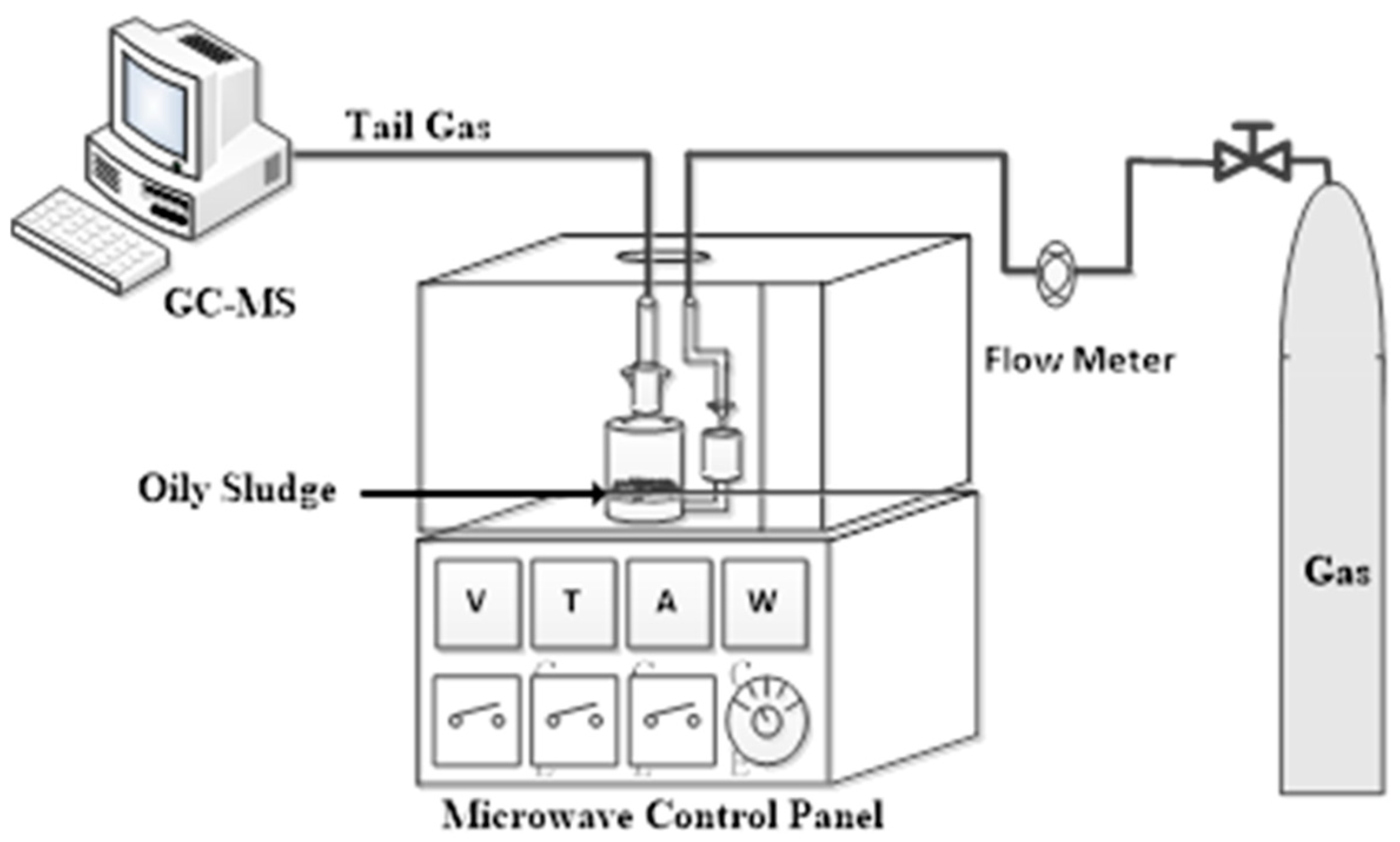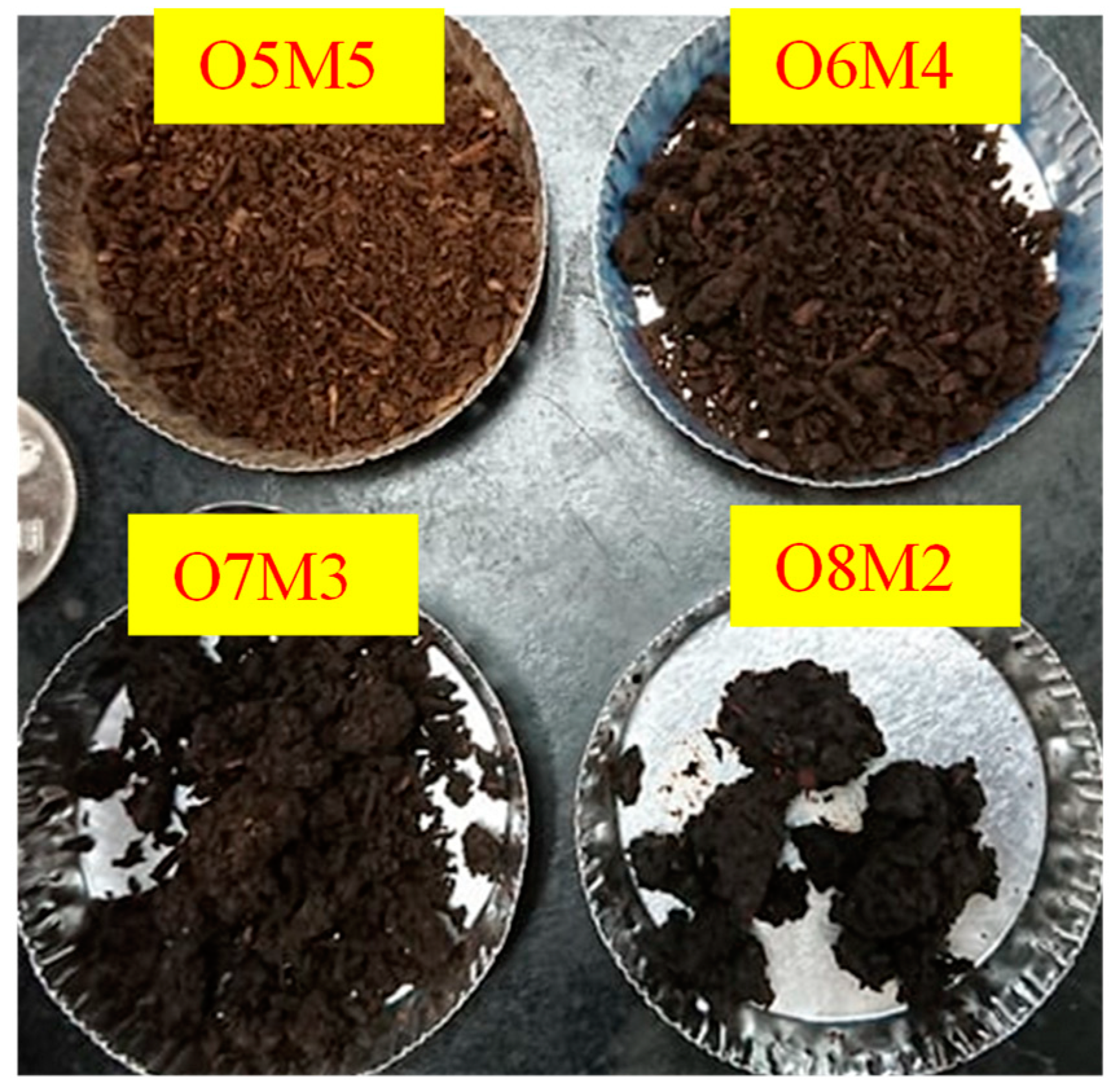Producing Refuse Derived Fuel with Refining Industry Oily Sludge and Mushroom Substrates
Abstract
1. Introduction
2. Materials and Methods
2.1. Experimental Materials
2.2. Experimental Methods
2.3. Analyses
3. Results and Discussion
3.1. BTEX Removal from Oil Sludge through Microwave Induction
3.2. Substance Analysis of Oily Sludge and Waste Mushroom Substrates
3.3. Producing RDF with Different Proportions of Oily Sludge and Waste Mushroom Substrates
3.4. Combustion Property Analysis of RDF Produced by Oily Sludge and Waste Mushroom Substrates
3.5. Heavy Metal Analysis of RDF Produced by Oily Sludge and Waste Mushroom Substrates
4. Conclusions
Author Contributions
Funding
Data Availability Statement
Conflicts of Interest
References
- Duan, M.; Li, C.; Wang, X.; Fang, S.; Xiong, Y.; Shi, P. Solid Separation From the Heavy Oil Sludge Produced From Liaohe Oilfield. J. Petrol. Sci. Eng. 2019, 172, 1112–1119. [Google Scholar] [CrossRef]
- Teng, Q.; Zhang, D.; Yang, C. A Review of the Application of Different Treatment Processes for Oily Sludge. Environ. Sci. Pollut. Res. 2021, 28, 121–132. [Google Scholar] [CrossRef] [PubMed]
- Hui, K.; Tang, J.; Lu, H.; Xi, B.; Qu, C.; Li, J. Status and Prospect of Oil Recovery From Oily Sludge: A Review. Arab. J. Chem. 2020, 13, 6523–6543. [Google Scholar] [CrossRef]
- Tang, X.; Wei, X.; Chen, S. Continuous Pyrolysis Technology for Oily Sludge Treatment in the Chain-Slap Conveyors. Sustainability 2019, 11, 3614. [Google Scholar] [CrossRef]
- Wang, Z.; Gong, Z.; Wang, Z.; Li, X.; Chu, Z. Application and Development of Pyrolysis Technology in Petroleum Oily Sludge Treatment. Environ. Eng. Res. 2021, 26, 190460. [Google Scholar] [CrossRef]
- Zhao, C.; Li, Y.; Gan, Z.; Nie, M. Method of Smoldering Combustion for Refinery Oil Sludge Treatment. J. Hazard. Mater. 2021, 409, 124995. [Google Scholar] [CrossRef] [PubMed]
- Zhong, H.; Qiu, Z.; Chai, J.; Guo, B.; Sun, D.; Liu, J. A preliminary Study of the Preparation of Shale Stabilizer With Oil Sludge-From Waste to Resource. J. Petrol. Sci. Eng. 2018, 161, 50–60. [Google Scholar] [CrossRef]
- Jones, D.A.; Lelyveld, T.P.; Mavrofidis, S.D.; Kingman, S.W.; Miles, N.J. Microwave heating applications in environmental engineering-a review. Resour. Conserv. Recycl. 2002, 34, 75–90. [Google Scholar] [CrossRef]
- Marken, F.; Sur, U.K.; Coles, B.A.; Compton, R.G. Focused microwaves in electrochemical processes. Electrochim. Acta 2006, 51, 2195–2203. [Google Scholar] [CrossRef]
- Tyagi, V.K.; Lo, S.L. Microwave irradiation: A sustainable way for sludge treatment and resource recovery. Renew. Sustain. Energy Rev. 2013, 18, 288–305. [Google Scholar] [CrossRef]
- Galinada, W.A.; Guiochon, G. Effect of microwave dielectric heating on intraparticle diffusion in reversed-phase liquid chromatography. J. Chromatogr. A 2005, 1089, 125–134. [Google Scholar] [CrossRef] [PubMed]
- Yuliarningsih, R.; Goembira, F.; Komala, P.S.; Putra, N.P.; Nasra, M. Oil Sludge and Biomass Waste Utilization as Densified Refuse-Derived Fuels for Alternative Fuels: Case Study of an Indonesia Cement Plant. J. Hazard. Toxic Radioact. Waste 2021, 24, 05020001. [Google Scholar] [CrossRef]
- Karpan, B.; Raman, A.A.A.; Aroua, M.K.T. Waste-to-Energy: Coal-Like Refuse Derived Fuel From Hazardous Waste and Biomass Mixture. Process Saf. Environ. Prot. 2021, 149, 655–664. [Google Scholar] [CrossRef]
- Li, W.; Yuan, Z.; Chen, X.; Wang, H.; Wang, L.; Lou, Z. Green Refuse Derived Fuel Preparation and Combustion Performance From the Solid Residues to Build the Zero-Waste City. Energy 2021, 225, 120252. [Google Scholar] [CrossRef]
- Hu, J.; Gan, J.; Li, J.; Luo, Y.; Wang, G.; Wu, L.; Gong, Y. Extraction of crude oil from petrochemical sludge: Characterization of products using thermogravimetric analysis. Fuel 2017, 188, 166–172. [Google Scholar] [CrossRef]
- Hu, G.; Li, J.; Zeng, G. Recent development in the treatment of oily sludge from petroleum industry: A review. J. Hazard. Mater. 2013, 261, 470–490. [Google Scholar] [CrossRef] [PubMed]
- Cong, K.; Han, F.; Zhang, Y.; Li, Q. The Investigation of Co-Combustion Characteristics of Tobacco Stalk and Low Rank Coal Using a Macro-TGA. Fuel 2019, 237, 126–132. [Google Scholar] [CrossRef]
- Li, X.; Miao, W.; Lv, Y.; Wang, Y.; Gao, C.; Jiang, D. TGA-FTIR Investigation on the Co-Combustion Characteristics of Heavy Oil Fly Ash and Municipal Sewage Sludge. Thermochim. Acta 2018, 666, 1–9. [Google Scholar] [CrossRef]
- Wang, T.; Hou, H.; Ye, Y.; Rong, H.; Li, J.; Xue, Y. Combustion Behavior of Refuse-Derived Fuel Produced From Sewage Sludge and Rice Husk/Wood Sawdust Using Thermogravimetric and Mass Spectrometric Analyses. J. Clean. Prod. 2019, 222, 1–11. [Google Scholar] [CrossRef]


| Sludge before MW Treatment | Sludge after MW Treatment | Waste Mushroom Substrates | |
|---|---|---|---|
| Moisture (%) | 17.58 | 8.04 | 9.07 |
| Ash (%) | 1.65 | 2.72 | 6.24 |
| Combustible content (%) | 80.77 | 89.24 | 84.69 |
| Heat value (HHV) (cal/g) | 9044 | 10,277 | 4173 |
| Unit volume weight (g/cm3) | 0.95 | 0.94 | 0.21 |
| Mixing Ratio (W/W) | ||||
|---|---|---|---|---|
| O8M2 | O7M3 | O6M4 | O5M5 | |
| Moisture (%) | 8.52 | 8.47 | 8.78 | 8.59 |
| Ash (%) | 4.05 | 4.16 | 4.44 | 4.66 |
| Combustible content (%) | 87.43 | 87.37 | 86.78 | 86.75 |
| Heat value (HHV) (cal/g) | 9176 | 8,452 | 7871 | 7279 |
| Unit volume weight (g/cm3) | 0.90 | 0.84 | 0.71 | 0.54 |
| Mixing Ratio (W/W) | ||||
|---|---|---|---|---|
| O8M2 | O7M3 | O6M4 | O5M5 | |
| DTGmax (%/min) | 8.14 | 8.05 | 8.07 | 9.23 |
| DTGmean (%/min) | 2.50 | 2.47 | 2.46 | 2.47 |
| Ti (°C) | 284.85 | 275.33 | 271.39 | 258.84 |
| Tp (°C) | 427.67 | 418.00 | 357.67 | 351.33 |
| Tb (°C) | 591.45 | 571.57 | 569.40 | 534.24 |
| Di (10−5) | 6.68 | 6.99 | 8.31 | 10.15 |
| S (10−7) | 4.23 | 4.59 | 4.73 | 6.37 |
| Heavy Metal (ppm) | Oily Sludge | Waste Mushroom Substrates | Mixing Ratio (W/W) | |||
|---|---|---|---|---|---|---|
| O8M2 | O7M3 | O6M4 | O5M5 | |||
| Hg | 0.21 | N.D. | 0.20 | 0.17 | N.D. | N.D. |
| Se | N.D. | 1.07 | 0.60 | 0.76 | 0.79 | 0.86 |
| Cr | N.D. | 3.12 | 2.17 | 2.31 | 2.66 | 3.04 |
| Pb | 0.67 | 0.37 | N.D. | N.D. | N.D. | N.D. |
| Cu | 0.47 | N.D. | N.D. | N.D. | N.D. | N.D. |
| Ba | 5.45 | 1.20 | 0.59 | 0.64 | 0.77 | 1.05 |
Publisher’s Note: MDPI stays neutral with regard to jurisdictional claims in published maps and institutional affiliations.
|
© 2022 by the authors. Licensee MDPI, Basel, Switzerland. This article is an open access article distributed under the terms and conditions of the Creative Commons Attribution (CC BY) license (https://creativecommons.org/licenses/by/4.0/).
Share and Cite
Lee, C.L.; Jou, C.-J.G. Producing Refuse Derived Fuel with Refining Industry Oily Sludge and Mushroom Substrates. Energies 2022, 15, 9451. https://doi.org/10.3390/en15249451
Lee CL, Jou C-JG. Producing Refuse Derived Fuel with Refining Industry Oily Sludge and Mushroom Substrates. Energies. 2022; 15(24):9451. https://doi.org/10.3390/en15249451
Chicago/Turabian StyleLee, Chien Li, and Chih-Ju G. Jou. 2022. "Producing Refuse Derived Fuel with Refining Industry Oily Sludge and Mushroom Substrates" Energies 15, no. 24: 9451. https://doi.org/10.3390/en15249451
APA StyleLee, C. L., & Jou, C.-J. G. (2022). Producing Refuse Derived Fuel with Refining Industry Oily Sludge and Mushroom Substrates. Energies, 15(24), 9451. https://doi.org/10.3390/en15249451





